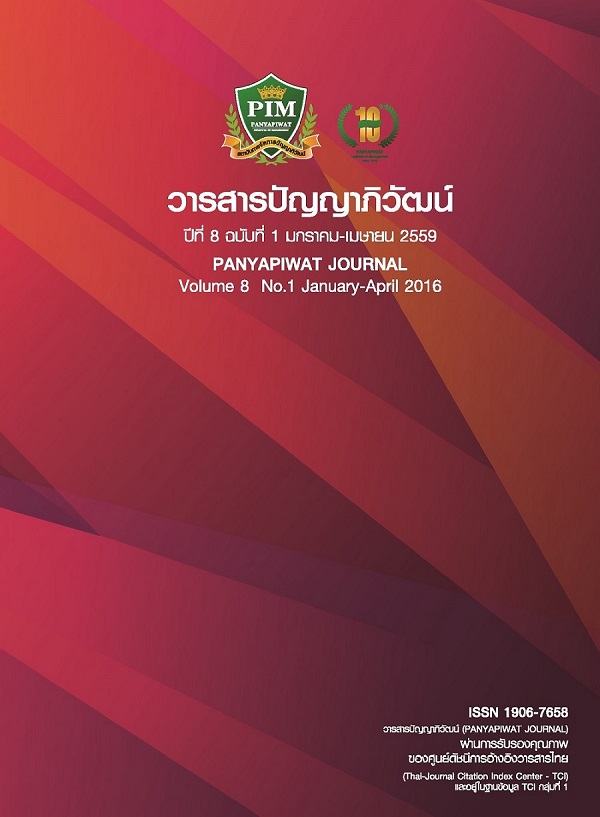ONLINE MARKETING STRATEGY FOR THAI COSMETICS IN CHINA
Main Article Content
บทคัดย่อ
This study aims to study the online marketing strategy for Thai cosmetic in China. With China’s rapid economic development, the cosmetics market becomes important parts of consumer markets. Thai cosmetic products are a new player in the Chinese online cosmetics market. Thus the research attempted to study the factors influencing consumer’s purchasing preference for Thai cosmetics from the online market in China. Through a basic descriptive statistics as well as multiple regression analysis model, the results reveal that the 4Cs marketing mix factors are significant in online marketing strategy for Thai cosmetics in China.
การศึกษานี้มีจุดประสงค์เพื่อศึกษากลยุทธ์การตลาดออนไลน์เพื่ออุตสาหกรรมเครื่องสำอางไทยในสาธารณรัฐประชาชนจีน ซึ่งปัจจุบันเศรษฐกิจในประเทศจีนเติบโตไปอย่างก้าวกระโดด และตลาดเครื่องสำอางได้กลายเป็นส่วนสำคัญของตลาดผู้บริโภค เครื่องสำอางไทยเป็นผู้เล่นใหม่ในตลาดเครื่องสำอางจีน โดยส่วนใหญ่จะใช้การตลาดออนไลน์ในการเข้าหาลูกค้าคนจีนเป็นหลัก งานวิจัยนี้จึงศึกษาเกี่ยวกับปัจจัยที่เอื้อต่อการซื้อของลูกค้าคนจีนต่อเครื่องสำอางไทยในตลาดออนไลน์ โดยจะทำการเก็บข้อมูลจากแบบสอบถามในประเทศจีนและนำมาวืเคราะห์ผลทางสถิติ ซึ่งปัจจัยที่ส่งผลต่อกลยุทธ์การตลาดออนไลน์จีนโดยเครื่องสำอางไทย คือ ราคาและคุณค่าของผลิตภัณท์ที่ลูกค้าจะได้รับและความสัมพันธ์ระหว่างสินค้าและลูกค้า
Article Details
“ข้าพเจ้าและผู้เขียนร่วม (ถ้ามี) ขอรับรองว่า บทความที่เสนอมานี้ยังไม่เคยได้รับการตีพิมพ์และไม่ได้อยู่ระหว่างกระบวนการพิจารณาลงตีพิมพ์ในวารสารหรือแหล่งเผยแพร่อื่นใด ข้าพเจ้าและผู้เขียนร่วมยอมรับหลักเกณฑ์การพิจารณาต้นฉบับ ทั้งยินยอมให้กองบรรณาธิการมีสิทธิ์พิจารณาและตรวจแก้ต้นฉบับได้ตามที่เห็นสมควร พร้อมนี้ขอมอบลิขสิทธิ์บทความที่ได้รับการตีพิมพ์ให้แก่สถาบันการจัดการปัญญาภิวัฒน์หากมีการฟ้องร้องเรื่องการละเมิดลิขสิทธิ์เกี่ยวกับภาพ กราฟ ข้อความส่วนใดส่วนหนึ่งและ/หรือข้อคิดเห็นที่ปรากฏในบทความข้าพเจ้าและผู้เขียนร่วมยินยอมรับผิดชอบแต่เพียงฝ่ายเดียว”
เอกสารอ้างอิง
Bennett, A. R. (1997). The Five Vs - A Buyer’s Perspective of the Marketing Mix. Marketing Intelligence & Planning, 15(3), 151-156.
Chong, K. W. (2003). The Role of Pricing in Relationship Marketing - A Study of the Singapore Heavy Equipment Spare. PhD Dissertation, International Graduate School of Management, University of South Australia.
CNNIC. (2015). 2014 China Online Shopping Market Research Report. Retrieved October 14, 2015, from http://www1.cnnic.cn/AU/MediaC/rdxw/2015n/201509/t20150914_52838.html
Euromonitor. (n.d.). Beauty and Personal Care in China. Retrieved October 14, 2015, from http://www.euromonitor.com/beauty-and-personal-care-in-china/report
Fung, G. (2013). China’s cosmetics market report 2012. FUNG group.
IR research. (2013). China cosmetic market 2012. Retrieved October 14, 2015, from http://www.iresearch.com.cn/coredata/2015q1_2.shtml#a3
IR research. (2015). China cosmetic market report 2014. Retrieved October 14, 2015, from http://report.iresearch.cn/2464.html
Lauterborn, R. (1990). New marketing litany: 4 P’s Passes. C-Words Take Over. Adverising Age, p. 1.
Li, H. (2012). Study on Marketing Strategy of South Korea Cosmetic in China. JILIN University China.
McCarthy, E. J. (1964). Basic Marketing. IL: Richard D. Irwin.
Möller, K. (2006). The Marketing Mix Revisited: Towards the 21st Century Marketing by E. Constantinides. Journal of Marketing Management, 22(3), 439-450.
NBS. (2015). 2014 National Economic and Social Development Statistics Bulletin. Retrieved October 14, 2015, from http://www.stats.gov.cn/tjsj/zxfb/201502/t20150226_685799.html
NNT (2015). Thai cosmetic. Retrieved October 14, 2015, from http://www.thaitradeusa.com/home/?p=19111
Palmer, A. (2004). Introduction to Marketing - Theory and Practice. UK: Oxford University Press.
Thai Trade Center Los Angeles. (2015). Commerce Min: Thai herbal products have a chance in Chinese market. Retrieved October 14, 2015, from http://www.thaitradeusa.com/home/?p=19111
Wong, B. (2015). China’s Cosmetics Market. Retrieved October 14, 2015, from http://china-trade-research.hktdc.com/business-news/article/China-Consumer-Market/China-s-cosmetics-market/ccm/en/1/1X000000/1X002L09.html


